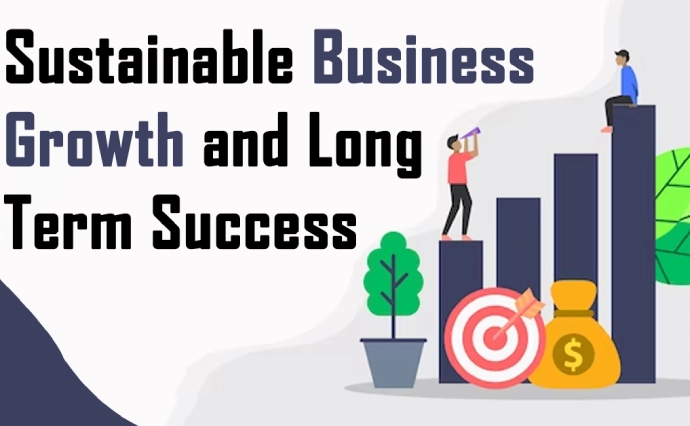Types of Business Growth
Growing a business is essential for success, but did you know there are different types of business growth? Each type has its own benefits and challenges, and understanding these options can help a company thrive. In this article, we will explore the various types of business growth and how they impact a company’s future. Whether you’re an entrepreneur or a student learning about business, this guide will make the topic easy to understand
Every business aims to grow. There are different ways that a company can expand. Each type of growth has its advantages and challenges. Understanding these types helps businesses choose the best strategy for their future. Let’s explore the main types of business growth.
Organic Growth: Growing Naturally
One of the most common types of business growth is organic growth. This type occurs when a company expands by selling more of its products or services. For example, if a bakery makes more cakes and sells them to more customers, it is experiencing organic growth.
How Organic Growth Happens: Types Of Business Growth
Organic growth happens naturally. Businesses increase their sales without needing outside help. They may improve their marketing strategies, create new products, or offer better services. As a result, more customers become interested. Because this type of growth depends on the business’s own efforts, it often takes time. However, it can be very stable.
Businesses love organic growth because it allows them to stay in control. They do not rely on loans or partnerships with other companies. This makes it a safe way to grow. On the downside, it can be slow, and sometimes companies want faster results.
Inorganic Growth: Expanding Quickly
Unlike organic growth, inorganic growth happens quickly. This occurs when a business buys another company or merges with it. By doing so, the business gains access to the other company’s customers, products, and market. For instance, if one fast-food chain buys another, it suddenly has more restaurants in more locations.
Benefits of Inorganic Growth: Types of Business Growth
Inorganic growth has many benefits. First, it is fast. A business can double its size almost overnight. Second, it allows businesses to enter new markets. For example, a company in the United States might buy a company in Europe to sell products there.
However, inorganic growth has its challenges too. Merging with or buying another company can be expensive. It also requires a lot of planning. If the two companies are very different, it might be hard to combine them successfully.
Internal Growth: Building from Within:
Internal growth focuses on improving what a company already has. Instead of buying new businesses, companies invest in their own operations. For example, a car company might decide to make its factories more efficient. By doing this, they can make more cars and sell them at lower prices.

Why Choose Internal Growth?
Internal growth is like organic growth but more focused on efficiency and improvement. Companies often choose this method when they want to be more competitive. By reducing costs and improving processes, they can offer better prices to customers. This attracts more buyers and leads to growth.
The downside of internal growth is that it requires significant investment upfront. Companies need to spend money on better equipment, training, or technology. However, the long-term rewards can be great.
External Growth: Expanding through Types of Business Growth Partnerships
External growth happens when a company partners with others. This type of growth is different from mergers or acquisitions. Instead of buying another business, companies work together. For example, a toy company might team up with a movie studio to create toys based on a popular film.
How External Growth Works
External growth can be a smart strategy. By partnering with other companies, businesses can reach new customers. They can also share resources and ideas. This can lead to faster growth without the high costs of buying another business.
However, partnerships also come with risks. If the companies do not work well together, the partnership could fail. Both sides need to trust each other and have the same goals.
Organic Growth: Building Naturally
Organic growth is one of the simplest types of business growth. It happens when a company expands its sales or production without the need for external help. For example, if a clothing store starts attracting more customers and selling more products, it is experiencing organic growth.
How Organic Growth Works: Types of Business Growth
Organic growth relies on a company’s internal efforts. Businesses achieve this by improving their marketing strategies, introducing new products, or reaching new customers. Since organic growth depends solely on the company, it often happens gradually.
While organic growth is steady, it can be slow. However, it is a great way for businesses to grow naturally over time without taking on too much risk.
Inorganic Growth: Expanding Quickly
In contrast to organic growth, inorganic growth occurs when a company grows by acquiring other businesses. For instance, when a big tech company buys a smaller competitor, it instantly gains new resources, customers, and technology.
The Benefits of Inorganic Growth
Inorganic growth offers businesses a quick way to grow. It allows them to expand into new markets or gain new expertise without having to build from scratch. However, it comes with its own set of challenges, such as the cost of buying another company or the effort needed to combine two different businesses.
Despite these challenges, inorganic growth can be an excellent way to achieve rapid expansion.
Internal Growth: Improving Operations
Another common type of business growth is internal growth. In this case, companies focus on improving what they already have. This can mean upgrading machinery, training employees, or developing better processes.
Why Internal Growth Matters
Internal growth is about making a business more efficient. Instead of looking for outside help, the company invests in its own operations. This type of growth can help a business become more competitive and reduce its costs over time.
Though it may require a large upfront investment, the long-term rewards of internal growth can be significant.
External Growth: Partnering with Others: Types of Business Growth
External growth happens when companies partner with others to expand their business. Instead of buying another business, they work together. For example, a food company might team up with a beverage company to sell products together.
How External Growth Boosts Businesses: Types of Business Growth
External growth allows businesses to share resources and knowledge. By collaborating with others, they can reach new customers or markets. However, the success of external growth depends on how well the partnership works.
While partnerships can offer great opportunities, they require trust and clear goals to succeed.
Diversification: Expanding into New Areas
Diversification is another form of growth. It happens when a company moves into a new industry or market. For example, a car manufacturer might start producing electric vehicles to reach a new audience.
The Power of Diversification: Types of Business Growth
Diversification can help a business protect itself from market changes. By having multiple revenue streams, a company can remain strong even if one part of the business faces challenges. However, entering a new market can be risky, as it requires new skills and knowledge.
Even so, many businesses diversify to stay competitive and adapt to changing market trends.
Market Penetration: Reaching More Customers
Market penetration is all about getting more customers for existing products. Businesses use this strategy to increase their market share. For example, a smartphone company might lower its prices to attract more buyers.
Benefits of Market Penetration
Market penetration helps businesses grow by making their products more accessible. This type of growth is often combined with aggressive marketing strategies to reach a broader audience.
While it can be effective, it may not be suitable for all companies, especially those with limited budgets.
Product Development: Creating New Offerings
Another common type of business growth is product development. This happens when a business creates new products to sell. For instance, a tech company might develop a new software application to complement its existing product line.
How Product Development Drives Growth: Types of Business Growth
Product development allows businesses to meet the changing needs of their customers. By offering new products, companies can attract new customers and keep existing ones engaged. However, developing new products requires significant research, time, and investment.
Despite the challenges, businesses that successfully innovate can achieve significant growth.
FAQs
1. What is the difference between organic and inorganic growth?
Organic growth occurs naturally through a company’s own efforts, while inorganic growth happens through mergers or acquisitions.
2. How does internal growth benefit a business?
Internal growth helps businesses become more efficient and competitive by improving their existing operations.
3. What are the main types of business growth?
The main types of business growth include organic growth, inorganic growth, internal growth, and external growth through partnerships.
4. Why do companies focus on product development for growth?
Companies focus on product development to meet changing customer needs and stay competitive by offering new and innovative products.
5. How can types of business growth help a company expand?
By choosing the right type of business growth, such as organic, inorganic, or external, companies can expand their market share and improve their long-term success.
6. What is the role of partnerships in external growth?
Partnerships in external growth allow companies to share resources and enter new markets without the costs associated with mergers or acquisitions.
7. How do types of business growth affect long-term success?
Choosing the appropriate type of business growth helps companies plan strategically, ensuring both short-term gains and long-term sustainability.
Conclusion
Businesses have many ways to grow. Whether through organic growth, inorganic growth, internal improvements, or external partnerships, each type has its benefits and challenges. By understanding these options, companies can make the best choices for their future success.
Choosing the Right Type of Growth Every business is different, and the right type of growth depends on the company’s goals, resources, and market conditions. Whether it’s organic, inorganic, internal, or external growth, each type has its advantages. By understanding these types of business growth, companies can make informed decisions and continue to succeed in a competitive world
Understanding the different types of business growth is essential for any company looking to expand. Whether a business chooses organic growth for a steady rise or inorganic growth for rapid expansion, each method has its unique benefits. Moreover, internal and external growth strategies can also offer various advantages, depending on the company’s goals. By considering all these options and using the right approach, businesses can grow successfully while adapting to ever-changing markets. Ultimately, selecting the best type of growth helps ensure long-term success and sustainability.
